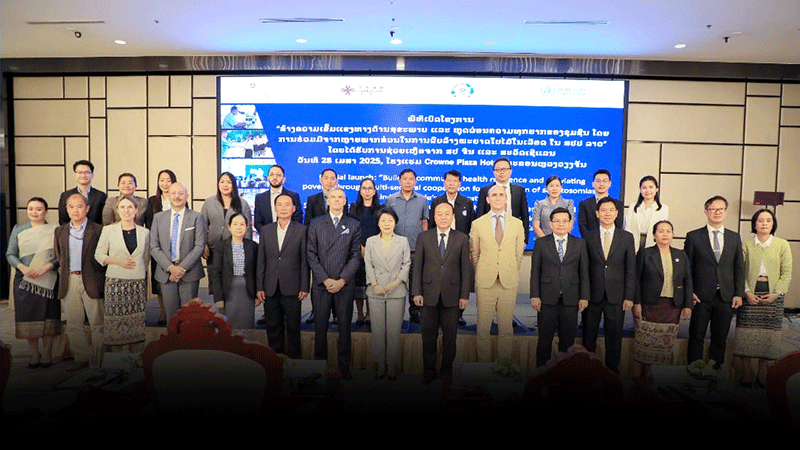 |
| Officials from the Ministry of Health, Chinese Embassy, WHO and other development partners launch a project to eliminate schistosomiasis in Laos. |
Health ministry unites with int’l partners to eliminate schistosomiasis
In a significant step towards eliminating schistosomiasis, the World Health Organisation (WHO) and Laos’ Ministry of Health have announced a new initiative supported by US$1.18 million in international funding.
The funding, provided by the China Global Development and South-South Cooperation Fund (GDF) and the Swiss Agency for Development and Cooperation (SDC), will strengthen national efforts to eliminate the parasitic disease over the next two years.
Approximately 120,000 people across 202 villages are affected, with school-aged children at highest risk. Left untreated, the disease can cause serious complications including liver enlargement, intestinal bleeding, infertility, and bladder cancer.
Speaking at a ceremony to launch the project on Monday, Minister of Health Dr Bounfeng Phoummalaysith said “This new funding and collaboration will enhance our capacity and enable us to intensify our control measures and move closer to elimination. Despite our efforts, schistosomiasis continues to affect thousands, especially children.”
Schistosomiasis is a disease caused by parasitic worms transmitted through freshwater snails and is a public health concern in Laos, particularly in Khong and Mounlapamok districts of Champassak province.
The joint funding includes US$680,263 from China’s GDF Fund and US$500,590 from Switzerland’s SDC, and will support a comprehensive action plan aimed at achieving zero new locally transmitted infections in humans, animals, and snails.
In collaboration with China’s National Institute of Parasitic Diseases, the Swiss Tropical and Public Health Institute, and the health ministries of Laos and Cambodia, the initiative will include mass drug administration for all residents in endemic areas; public health education campaigns to promote disease prevention; disease surveillance and laboratory testing; improved water and sanitation infrastructure; and implementation of the National Action Plan for Schistosomiasis Elimination from 2025–2035
The project will also include cooperation with Cambodia, where similar efforts in surveillance, treatment, and infrastructure improvement are underway. Data and best practices will be regularly shared between the two countries to maximise impact.
WHO Representative in Laos Dr Tim Armstrong said “Schistosomiasis is an unwelcome health risk causing a range of tragic health impacts – one that we are close to eliminating,”
“Sustained investment and commitment have brought infection rates to under 1 percent in high-risk areas, but continued efforts are crucial to protect vulnerable communities.”
The Chinese Ambassador to Laos, Mrs Fang Hong, emphasised China’s role in promoting global health through South-South cooperation. “This project is not only about disease prevention but also about strengthening community resilience and empowering local development,” she said.
Jean-Gabriel Duss, Regional Director for the SDC in the Mekong Region, added, “By joining forces and mobilising Swiss expertise, we aim to improve lives along the mighty Mekong.”
In recent years, notable progress has been made in Laos’ battle against communicable diseases, with the elimination of trachoma in 2017 and lymphatic filariasis in 2023, and a reduction in malaria cases from hundreds of thousands in the 1990s to under 500 in 2024, according to the World Health Organisation.
By Phetphoxay Sengpaseuth
(Latest Update April 30, 2025)
|


